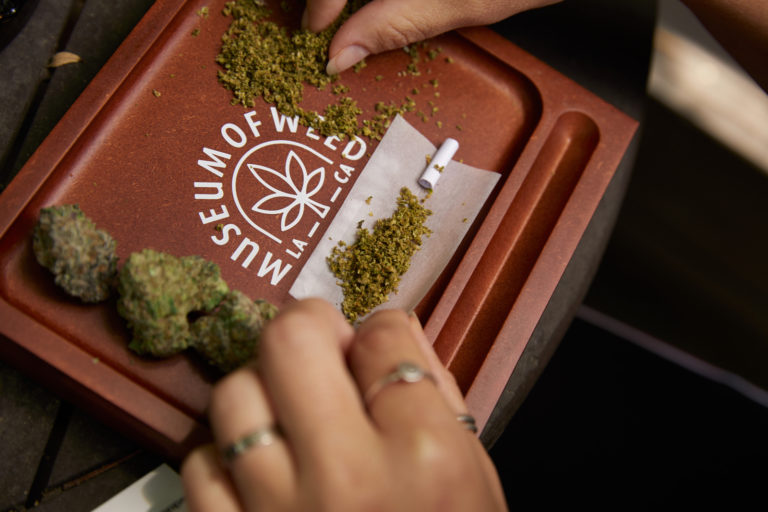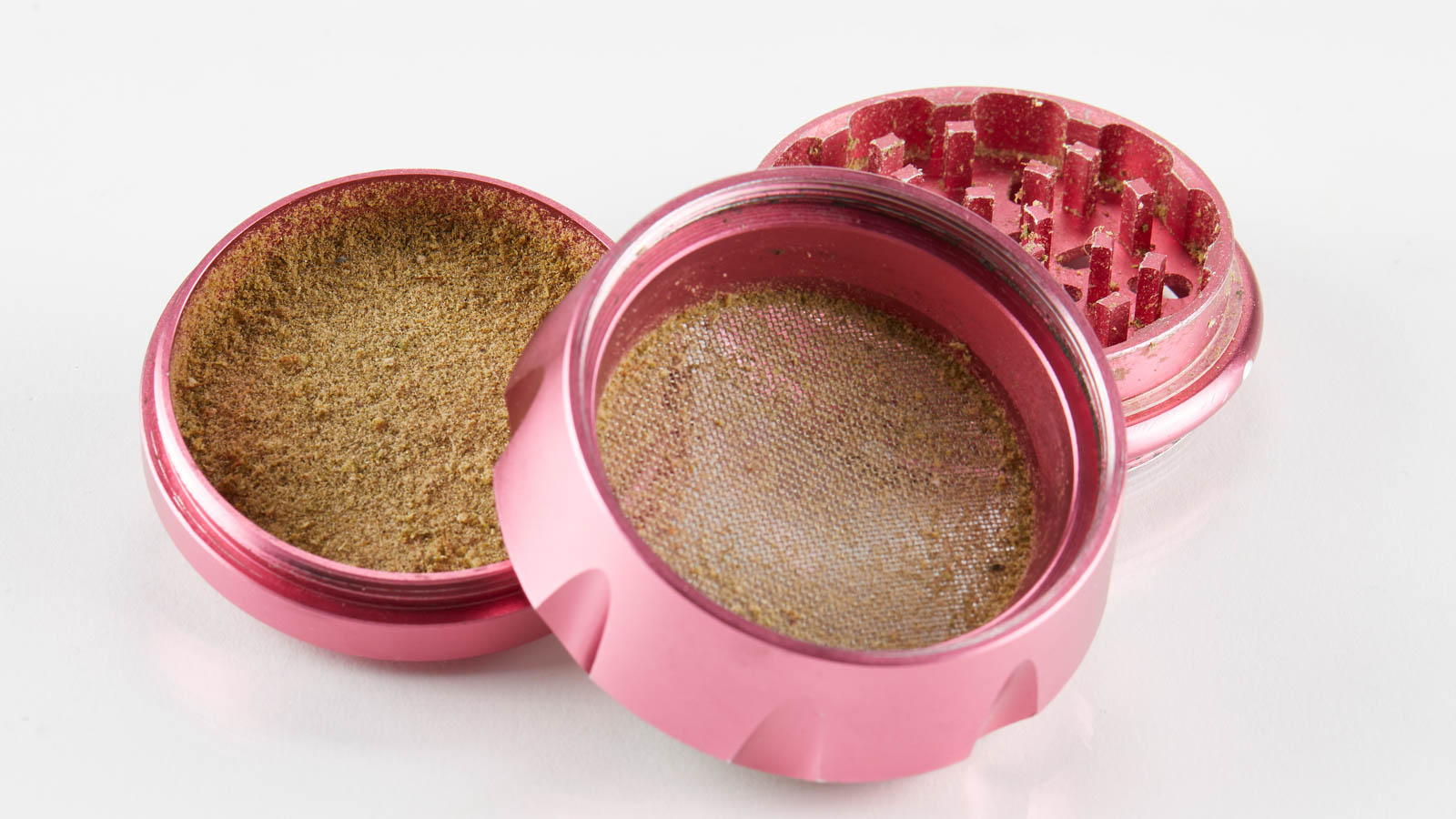A device used for grinding weed that breaks cannabis flowers into smaller pieces for joints, blunts, and bowls. Place the nug in between the teeth of the weed grinder, then twist the top and bottom of the grinder in opposite directions to break down the flower. Herb grinders may include a kief catcher in the bottom chamber to gather the kief knocked off from the nug in the grinding process.
He put the nug in the stainless steel herb grinder to break up the flower.
The herb grinder was necessary to get the weed ready to roll into a joint.
 Photo by: Gina Coleman/Weedmaps
Photo by: Gina Coleman/WeedmapsImage lightbox

Who invented the herb grinder?
The grinder's roots date all the way back to the early 20th century when Lewis Heim, an engineer who worked for The Ball and Roller Bearing Co. in Danbury, Connecticut, invented the first centerless grinding machine as an industrial tool for processing plant matter on a large scale.
People soon realized the centerless grinding machine could also be effective at processing plant matter individually, and it was eventually made smaller for use in pharmacies and apothecaries. Grinders started to gain popularity as a way to break down cannabis flower in the 1960s.
What is an herb grinder used for?
The purpose of an herb grinder is to grind marijuana buds down to a finer consistency that is smooth and balanced. Grinders are used primarily to improve the smoking experience by breaking down cannabis flower evenly. You may not need a grinder to break nugs down into smaller pieces, but using one decreases the likelihood of clogging your pipe, allows you to vape flower more evenly, and makes joints and blunts burn more smoothly.
 Photo by: Gina Coleman/Weedmaps
Photo by: Gina Coleman/WeedmapsImage lightbox

Grinders provide a variety of other benefits to cannabis users. They can save you some time by making it quicker and easier to break up your weed. Using a grinder also helps to preserve trichomes, which can get knocked off your nugs when you handle them too much.
For anyone with arthritis, grinders can also negate the pain and hassle of breaking up small buds by hand. Grinders can, however, require a certain amount of force to cut through stickier buds. Arthritis patients should either seek out grinders known for their ease of use, or take extra caution when dealing with a sticky cannabis strain.
What different types of grinders can I buy?
While the basic mechanics of the grinder have remained the same throughout the years, since being adopted by cannabis consumers, additions have been made to the design to increase efficiency. Today, grinders come in many shapes and sizes.
At their core, they use two fittable components that each have small sharp teeth to chop up your bud as your twist the two components in opposite directions with your hands. You can find a grinder with your favorite sports team's logo or with decorations to fit your personal taste. Grinders you'll find today are normally made of three materials:
Metal
While metal grinders may be slightly more expensive than grinders made from other materials, they're a top choice for many cannabis users thanks to their durability and efficiency. The teeth tend to stay sharper, making it easier to break down flower. Metal grinders are also easy to clean.
Wood
Wooden grinders are often the most artistic in design, but they're much harder to clean and less efficient because resin and residue tend to build up in wooden grinders, making them less effective over time.
Plastic
Plastic is by far the most affordable grinder material, but also the least reliable. The teeth of a plastic grinder can dull rather quickly — or break off entirely — making it much more challenging to break down flower.
Grinder Sizes
In addition to various materials, grinders also come in different sizes, from a two-piece grinder great for a casual user all the way to a five-piece grinder for a seasoned smoker.
The different standard grinder sizes include:
5-piece grinder
Five-piece grinders include:
- A lid (the top of the grinder)
- Grinding chamber
- Storage chamber
- Two kief catchers
What's the best grinder for kief?
The kief catcher, located at the bottom of the grinder, makes the 5-piece grinder the best grinder for kief. This grinder conveniently collects all the kief that falls off your bud when it is being ground. Your bud chamber will have a screen that allows trichomes to fall through to the catcher.
4-piece grinder
You can also opt for a 4-piece herb grinder. A 4-chamber grinder includes:
- A lid
- Grinder bottom
- Storage chamber
- Kief catcher
3-piece grinder
The 3-chamber grinder includes a lid, grinding chamber, and storage chamber.
 Photo by: Gina Coleman/Weedmaps
Photo by: Gina Coleman/WeedmapsImage lightbox

2-piece grinder
These simpler devices are usually more inexpensive than three-, four-, or five-piece units. They simply include a lid and a grinder bottom, which doubles as a bud catcher.
Flat grinder
Flat grinders sacrifice some functionality for convenience and space-savings. These grinders are meant to easily fit in a pocket or wallet, and have a close resemblance to a cheese grater.
Electric grinder
Electric grinders are options for anyone who needs a completely hassle- and pain-free way of breaking up bud.
Where to get a weed grinder
Grinders are available both online and at almost any smoke shop, head shop, or glass gallery. Technically speaking, they are marketed as “herb” or “spice” grinders, which means they're fully legal and available from everyday retailers. However, if cannabis residue is found on a grinder in a region where cannabis hasn't been legalized, it could be considered drug paraphernalia and subject to criminal penalties.
How to use a grinder
- Take off the lid.
- Break up your cannabis flower and put the nugs in between the teeth of the grinder.
- Put the lid back on the grinder and rotate about 10 to 15 times, until all the flower has fallen into the storage chamber. You may need to repeat this process after tapping the lid to loosen up any pieces that stuck within the grinder's teeth.
- Unscrew the storage chamber and remove the broken-down flower to use in joints, blunts, or bowls.
 Photo by: Gine Coleman/Weedmaps
Photo by: Gine Coleman/WeedmapsImage lightbox

Using a grinder vs. breaking by hand
While using a grinder has several benefits, breaking your flower by hand may at times produce a better smoke experience. It may also be better to break up some flower by hand if it is unusually resinous and sticky, and therefore more likely to gunk up your grinder. Some flower smokers prefer to break up bud by hand to foster a close connection with the cannabis plant.
What to do with the kief collected in your grinder?
If your grinder has a kief catcher, as kief accumulates over time, you can scrape it out with a piece of paper and use the kief in a recipe for an edible or sprinkle it on top of a joint, blunt, or bowl for added potency. You can also press kief into hash or rosin, or sprinkle some in your coffee or tea.
 Photo by: Gina Coleman/Weedmaps
Photo by: Gina Coleman/WeedmapsImage lightbox

When not to use a grinder
Resin buildup in your grinder is more or less inevitable, but depending on the quality of your grinder, an especially sticky bud can clog up your grinder after one or two uses. If you're working with particularly sticky or resin-coated flower, you may want to consider breaking it up with your hand.
Never put moon rocks in your grinder. Moon rocks are cannabis nugs dipped in extracts and rolled in kief. They will completely gunk up your grinder and remove most of the moon rock's kief coating. Also, avoid putting any other type of concentrate-infused flower through a grinder.
How to clean a gunked-up grinder
When dealing with sticky, resinous cannabis, the buildup of gunk can cause even the most well-made grinder to not work as well as it did when new.
Similar to cleaning all other things cannabis-related, isopropyl (rubbing) alcohol is a good starting point to clean a grinder. Give each piece of your grinder a good rubbing down with isopropyl alcohol and salt (Epsom, kosher, or even normal table salt works).
 Photo by: Gina Coleman/Weedmaps
Photo by: Gina Coleman/WeedmapsImage lightbox

For especially tough cases, unscrew each piece of your grinder and soak it in a small container of isopropyl alcohol. After a few hours, you should be able to remove the pieces. Then, wash them thoroughly with soap and water and they should be good as new.

